 |
Photo of a Cave entrance by kobitriki from
https://pixabay.com/photos/cave-tunnel-underground-entrance-94193/ |
This world history resource focuses on prehistory to 2500 B.C. and includes quiz questions and answers along with video links to related topics.
We utilized World History: Patterns of Interaction (Holt McDougal)
for our world history textbook.
It has multiple options for different learning styles
and covers a wide array of information.
I designed the following quiz questions and answers
to accompany Chapter 1: pages 2-25.
Directions for the quiz:
- Scroll down and click on the thumbnail to enlarge to full screen.
- Click on the graphic to advance to the next screen.
- Choose an answer for each question.
- Compare your answers with those provided.
If you are interested in a group and/or interactive version of this quiz, log in to Kahoot! and search for Week 1 World History by Katrena.
I utilized the following videos to accompany chapter 1:
Thanks for visiting my StudentSurvive2Thrive blog! Feel free to search for resources via the site map, topics on the right or my search bar.
Below are additional articles you may wish to review:
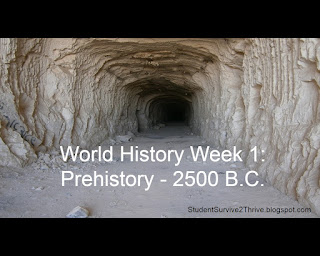 |
| World History Week 1: The Peopling of the World Prehistory to 2500 B.C. |
 |
| Created by Katrena All rights reserved. |
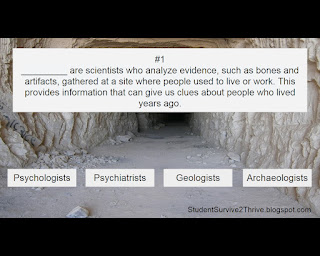 |
_________ are scientists who analyze evidence, such as bones and artifacts,
gathered at a site where people used to live or work.
This provides information that can give us clues about people who lived years ago.
Answer choices are: Psychologists, Psychiatrists, Geologists, Archaeologists |
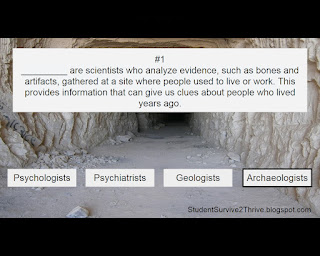 |
| The correct answer is Archaeologists. |
 |
________ study fossils and rocks to determine how old these remains are.
Answer choices are: Paleontologists, Anthropologists, Archaeologists, Podiatrists |
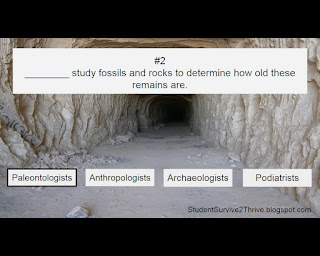 |
| The correct answer is Paleontologists |
 |
_______ is a way of living for a particular
group of people and includes common practices,
organization of social groups, beliefs, language, and more.
Answer choices are: Religion, Culture, Economics, Politics |
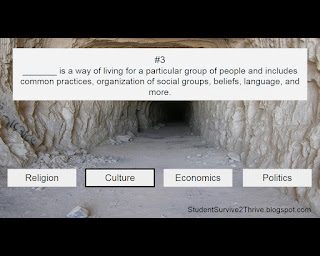 |
| The correct answer is culture. |
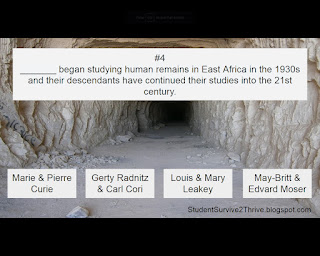 |
_______ began studying human remains in East Africa
in the 1930s and their descendants have continued their studies into the 21st century.
Answer choices are: Marie & Pierre Curie, Gerty Radnitz & Carl Cori,
Louis & Mary Leakey, May-Britt & Edvard Moser |
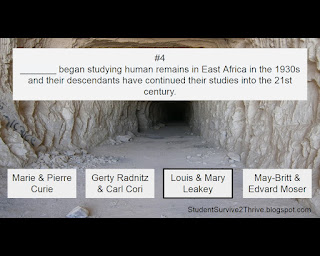 |
| The correct answer is Louis & Mary Leakey. |
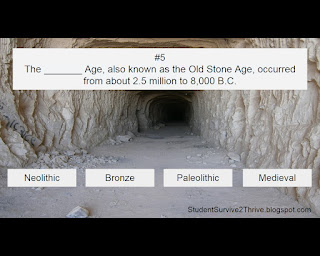 |
The _______ Age, also known as the Old Stone Age,
occurred from about 2.5 million to 8,000 B.C.
Answer choices include: Neolithic, Bronze, Paleolithic, Medieval |
 |
| The correct answer is Paleolithic. |
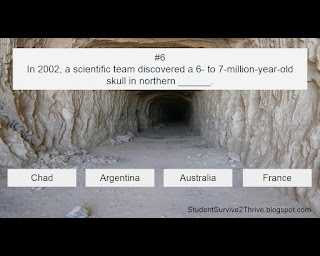 |
In 2002, a scientific team discovered a 6- to 7-million-year-old
skull in northern ______.
Answer choices include: Chad, Argentina, Australia, France |
 |
| The correct answer is Chad. |
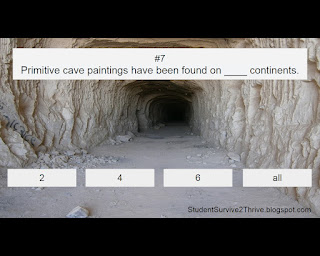 |
Primitive cave paintings have been found on ____ continents.
Answer choices include: 2, 4, 6, all |
 |
| The correct answer is all. |
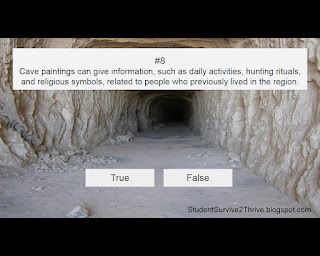 |
Cave paintings can give information, such as daily activities,
hunting rituals, and religious symbols, related to people
who previously lived in the region.
Answer choices include: true, false |
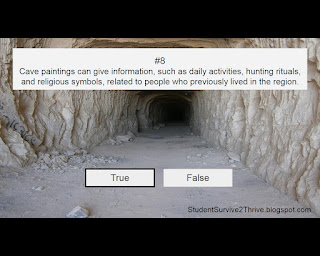 |
| The correct answer is true. |
 |
People who moved from place to place while searching
for new sources of food are called _______.
Answer choices include: hermits, farmers, urbanites, nomads |
 |
| The correct answer is nomads. |
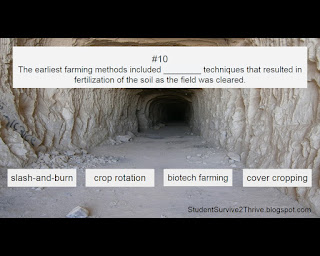 |
The earliest farming methods included ________ techniques that
resulted in fertilization of the soil as the field was cleared.
Answer choices include:
slash-and-burn, crop rotation, biotech farming, cover cropping |
 |
| The correct answer is slash-and-burn. |
 |
As people began to create villages, they began to tame wild animals.
This is known as _______.
Answer choices include: hunting, domestication, tribing, urbanization |
 |
| The correct answer is domestication. |
 |
Which of the following is/are a characteristic(s) of a civilization?
Answer choices include: complex institutions & advanced cities,
record keeping & advanced technology, specialized workers, all of these |
 |
| The correct answer is all of these. |
 |
Some people, called ______, lived in cities and specialized in specific jobs
such as making jewelry or pottery or fashioning weapons or clothing.
Answer choices include: professors, chiefs, artisans, physicians |
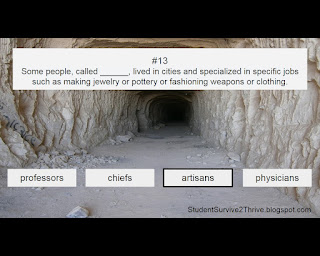 |
| The correct answer is artisans. |
 |
_______ was an ancient village in south-central Turkey located near a twin-coned volcano.
Answer choices include: Catal Huyuk, Ur, Nippur, Machu Picchu |
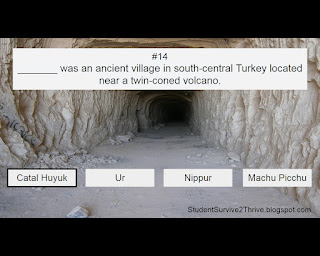 |
| The correct answer is Catal Huyuk. |
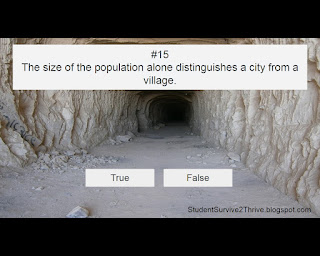 |
The size of the population alone distinguishes a city from a village.
Answer choices include: true, false |
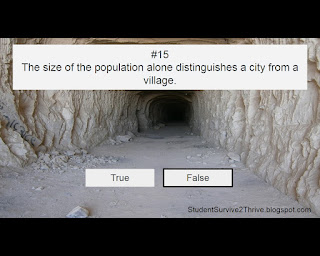 |
| The correct answer is false. |
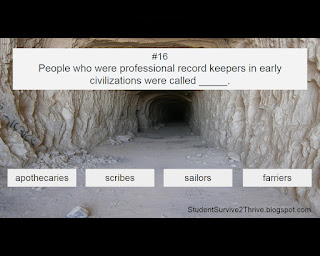 |
People who were professional record keepers in early civilizations were called _____.
Answer choices include: apothecaries, scribes, sailors, farriers |
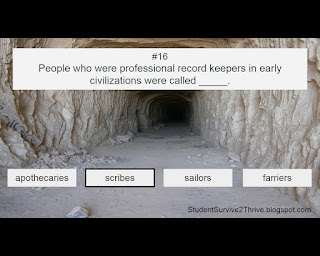 |
| The correct answer is scribes. |
 |
The Incan civilization used a set of colored strings tied with
knots of various sizes and particular intervals to keep records.
This was called a(n) ______.
Answer choices include: abacus, calculator, quipu, cuneiform |
 |
| The correct answer is quipu. |
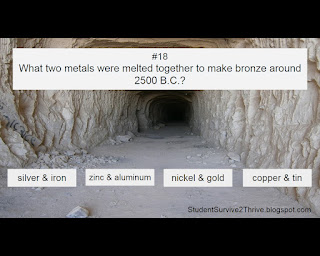 |
What two metals were melted together to make bronze around 2500 B.C.?
Answer choices include:
silver & iron, zinc & aluminum, nickel & gold, copper & tin |
 |
| The correct answer is copper & tin. |
 |
A method of trading goods and services without using money
is called ______ and was used in early civilizations.
Answer choices include: scalping, shoplifting, gaslighting, bartering |
 |
| The correct answer is bartering. |
 |
At the center of Ur stood a tall pyramid-shaped monument
or temple called a _______, which was later damaged during the Persian Gulf War.
Answer choices include: mosque, ziggurat, tabernacle, olympieion |
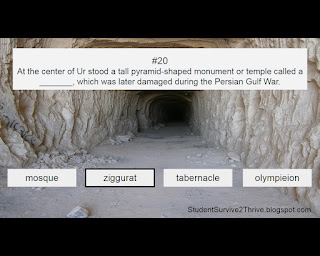 |
| The correct answer is ziggurat. |
 |
| Find more resources at StudentSurvive2Thrive.blogspot.com |












































No comments:
Post a Comment
Thanks for reading my article and sending your comment! Please note that I do not place links to other web sites on this blog.
Note: Only a member of this blog may post a comment.